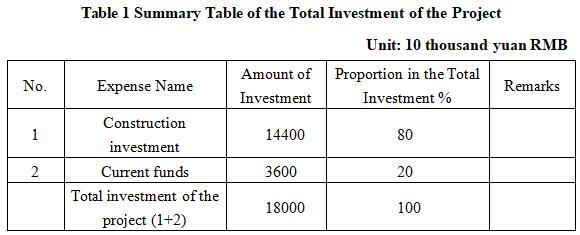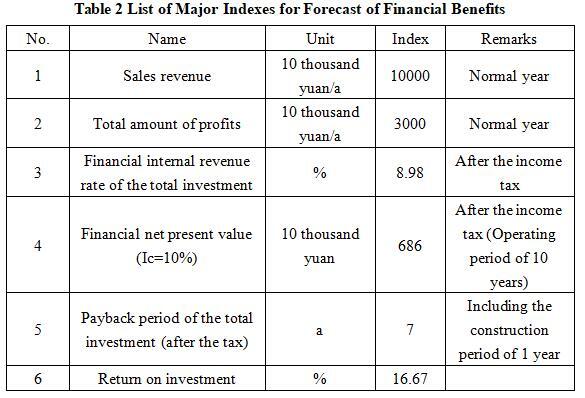Processing of Agricultural Products and Food
15000-ton/year Seafood Processing Project of Yanbian Prefecture
1. Introduction to the Project
1.1 Project background
1.1.1 Product introduction
The project is located in Tumen Border Economic Cooperation Zone in Jilin Province. The distance from Tumen to Hunchun Port on the expressway is 53 kilometers. Hunchun is close to the sea but not a coastal area. It is an important seafood product distribution center in northern China. There are multiple high-quality ports distributed around, and the adjacent waters can produce millions of tons of aquatic products annually. The project relies on the advantages of seafood resources to fully meet the supply guarantee of surrounding seafood enterprises.
1.1.2 Market prospect
(1) Analysis of the market situation of seafood products in China
Marine organisms and their processed products are collectively referred to as seafood. These products are a treasure trove of high-quality protein, containing various essential amino acids for the human body and rich polyunsaturated fatty acids, which are of great benefit to national health. In recent years, the proportion of seafood in the dietary structure of Chinese residents has continued to rise, with annual consumption increasing at a rate of 3%. With the steady growth of China’s economy, the increase in income of urban and rural residents, and the advancement of urbanization, people’s living standards are constantly improving, and the demand for seafood is increasing year by year, especially for high-quality and high priced seafood.
As a major player in global marine aquaculture, China leads the world in terms of aquaculture area and total output. However, due to factors such as overfishing and environmental pollution, marine aquatic resources have decreased, leading to a gradual shift in China’s aquaculture industry towards aquaculture, thereby promoting the rapid development of the marine aquaculture industry.
At present, the Chinese seafood market is showing a strong development momentum. With the sustained growth of the domestic economy and the improvement of consumer living standards, the consumption of seafood continues to rise. At the same time, the continuous innovation of aquaculture technology and the updating of fishing equipment have also promoted the stable growth of seafood production.
In the field of aquaculture, China’s seafood industry has achieved large-scale and intensive management. Each region has developed its own aquaculture industry with local characteristics based on its own resources and environmental features. For example, coastal areas utilize their abundant marine resources to develop marine aquaculture, while inland areas utilize freshwater resources to develop freshwater aquaculture. The development of these aquaculture industries not only improves the yield and quality of seafood, but also creates employment opportunities and income sources for local farmers.
In terms of fishing, by utilizing fishery resources reasonably and improving fishing techniques, the catch of Chinese seafood has maintained stable growth. The government has also strengthened the protection and management of fishery resources, implemented measures such as fishing bans and restrictions on fishing intensity to ensure the sustainable use of fishery resources.
From the perspective of production, although the area of marine aquaculture in China has decreased, the total production of marine aquaculture products is showing an upward trend. According to data, the total production of seafood in China has been increasing year by year from 2015 to 2023, reaching 71.1624 million tons in 2023. With the increasing demand for seafood among residents, the growth of the supply side will continue to be driven.
(2) Market prospect analysis of seafood products
Currently, China’s seafood market is showing a thriving development trend. With the continuous growth of the economy and the improvement of residents’ living standards, consumers’ demand for seafood is increasingly strong. Seafood, with its high protein and low-fat nutritional characteristics, has become an important component of a healthy diet. At the same time, China’s seafood production continues to grow, with a wide variety of species including fish, shrimp, crabs, shellfish, and algae, meeting the diversified needs of the market. The development of cold chain logistics provides strong guarantees for the preservation and rapid circulation of seafood, further enhancing the market competitiveness of products.
The potential of China’s seafood market is enormous, especially driven by the trend of healthy eating. Seafood, as a high-quality source of protein and trace elements, is highly favored by consumers. In addition, the expansion of export trade has also brought new growth points to China’s seafood market. With abundant seafood resources and continuously improving product quality, China’s seafood products have demonstrated strong competitiveness in the international market. At the same time, the rise of leisure fishing has opened up new application scenarios for the seafood market, such as tourism and entertainment, bringing new development opportunities for the seafood industry.
However, China’s seafood market also faces many challenges. Overfishing and marine environmental pollution pose a serious threat to seafood resources, and strengthening marine ecological protection and promoting sustainable fishing models have become urgent tasks. In addition, the intensification of competition in domestic and international markets requires seafood companies to continuously improve product quality and added value, strengthen brand building, and win the market with differentiated competition strategies. The government should increase its support for the seafood industry, and help it achieve high-quality development through policy measures such as tax incentives, financial support, technology research and development, and promotion. At the same time, seafood companies should actively respond to market changes, strengthen technological innovation and product research and development, enhance product competitiveness, and jointly promote the prosperity and development of China’s seafood market.
Tumen City, with its unique geographical location and abundant marine resources, has shown broad development prospects in the field of seafood processing. From the perspective of industrial upgrading, the seafood processing project in Tumen City can not only enhance the added value of local traditional fisheries, but also promote the deep integration of fisheries with modern manufacturing and service industries, and promote the optimization and upgrading of industrial structure.
At the same time, with the increasing demand of consumers for the quality and diversity of seafood, the seafood processing projects in Tumen City have also ushered in a good opportunity for market expansion. By introducing advanced processing technology and equipment, improving the quality and taste of products, and meeting the diverse needs of domestic and international markets, Tumen City is expected to become an important supply base for seafood processing in Northeast Asia and even globally.
In addition, the project can also create a large number of employment opportunities for the local area, improve the income level of residents, and further promote the prosperity and development of the regional economy. Therefore, the seafood processing project in Tumen City undoubtedly has broad development prospects and huge market potential.
1.1.3 Advantageous conditions of project construction
(1) Policy advantages
The National Marine Ranch Demonstration Zone Construction Plan (2017-2025) proposes to have created 200 national marine ranch demonstration zones with strong regional representation, outstanding ecological functions, typical demonstration and radiation driving effects nationwide by 2025. At the same time, considering the different sea conditions, development levels, and types of marine pastures in various regions, the planning and construction quantity shall be implemented based on the principle of overall coordination and dynamic adjustment between different regions.
Jilin Provincial Committee of the Communist Party of China and Jilin Provincial People’s Government propose to support Hunchun in developing its marine economy and building a modern industrial system. It will promote the rapid development of the marine industry. In terms of industrial policies, development plans, and factor inputs, it will support Hunchun in accelerating the development of marine biopharmaceuticals, marine health foods, marine chemicals, marine environmental protection, offshore fishing, deep processing and cold chain logistics of seafood, marine finance, marine education, and cross-border coastal tourism along the river.
(2) Location advantages
The highways, railways, and shipping lines within Tumen City have become important international transportation hubs connecting the hinterland of Northeast China and the Far East region due to their location in the “Golden Triangle” of Northeast Asia. With the completion of the most beautiful high-speed railway in Northeast China, Tumen’s regional advantage has become more apparent. The successive opening of 16 domestic routes from Yanji, adjacent to the state capital, to Beijing, Shanghai, Ningbo, and 9 international routes to foreign destinations has made it increasingly convenient for friends from all over the country and even the world to travel to Tumen.
(3) Resource advantages
Yanbian Prefecture is located in the eastern region of Jilin Province, adjacent to Russia and North Korea, and has abundant pollution-free seafood resources. Yanbian Prefecture has achieved significant results in the green development of aquaculture, implementing multiple technology projects promoted by the Ministry of Agriculture and Rural Affairs, and completing a fishery policy support project for the seafood processing industry with Hunchun as the main body. As of the end of September, 2023, the aquaculture water surface area in Yanbian Prefecture is 30226.67 hectares, with a total aquatic product output of 8.8995 million kilograms. The annual aquatic product output is reached about 12.6 million kilograms, and the output value is reached about 9.6 billion yuan.
1.2 Contents and scale of project construction
1.2.1 Product scale
The project produces 15000 tons of seafood annually.
1.2.2 Construction contents of the project
The project covers an area of 20000 square meters with a building area of 29000 square meters, mainly including the standard factory building, cold storage, dormitories, etc., and purchases the corresponding production and processing equipment, environmental protection equipment, and supporting infrastructure such as water and electricity facilities, etc.
1.3 Total investment of the project and capital raising
The total investment of the project is 180 million yuan, including the construction investment of 144 million yuan.

1.4 Financial analysis and social evaluation
1.4.1 Main financial indexes
After the project reaches the production capacity, its annual sales income will be 100 million yuan, its profit will be 30 million yuan, its investment payback period will be 7 years (after the tax, including the construction period of 1 year) and its return investment will be 16.67%.

Note: “10 thousand yuan” in the table is in RMB.
1.4.2 Social evaluation
This project is conducive to promoting the trading and circulation of seafood products in Northeast Asia, and driving the development of the regional economy; it is beneficial for promoting the establishment of a clean production model for seafood and protecting the ecological environment of its surrounding waters; it develops environment-friendly industries, reduced environmental pollution, improves product quality and efficiency, and achieves no environmental harm. It will ensure the healthy, orderly and efficient utilization of environmental resources and provide the strong support for the sustainable development of other related industries, driving regional economic development.
1.5 Cooperative way
Sole proprietorship, joint venture or cooperation
1.6 What to be invested by the foreign party
Funds or other means can be discussed in person.
1.7 Construction site of the project
Jilin Tumen Border Economic Cooperation Zone
1.8 Progress of the project
The project proposal has been prepared.
2. Introduction to the Partner
2.1 Basic information
Name: Investment Promotion Bureau of Jilin Tumen Border Economic Cooperation Zone
Address: 688 Fengwu Road, Tumen Economic Development Zone, Jilin Province
2.2 Overview
Tumen City is located in the east of Jilin Province, at the east foot of the Changbai Mountains, and at the lower reaches of Tumen River. It faces Hwaseong gun, North Hamgyong, Korea across the river, adjacent to Hunchun City in the east, Yanji City, the prefecture capital in the west, Longjing City in the south, and Wangqing County in the north.
Tumen City is 35 kilometers away from Yanji Airport. Tumen City is an important post station for Hunchun-Ulanhot Expressway, Changchun-Hunchun High-speed Railway, Northeast Eastern Railway, and the Eastern Corridor advocated by China-Mongolia-Japan Border Committee. “Going to the sea via a port” can connect foreign countries and various port cities along the southeast coast of China through railways, and has important functions of “connection”, “radiation”, and “distribution”. It is an important node connecting the surrounding areas, the coast, and Europe and America. It is a must pass place for Jilin Province to “go to the sea via a port” and an important forefront of the development and opening up pilot zone of Changchun-Jilin-Tumen.
Tumen City has abundant intangible cultural heritage resources, with a total of 47 intangible cultural heritage projects at various levels, including the Korean tribal leader's encouragement, Korean ethnic “Si opera”, and Korean rice sausage making techniques. In order to revitalize the inheritance of intangible cultural heritage, Tumen City integrates “tourism+intangible cultural heritage”, relying on traditional festivals, tourism golden weeks and other time nodes, and leveraging the popularity of tourism to hold intangible cultural heritage project exhibitions, intangible cultural heritage amusement project displays, and non genetic unified beauty food tasting activities, allowing more tourists to experience the charm of cultural treasures up close. Tumen City is upgrading and renovating the Chinese Korean Intangible Cultural Heritage Exhibition Hall, in order to leverage the pivot of the cultural tourism industry and make it a shining “cultural business card” of Tumen City.
In 1985, Tumen City was approved by the state as a Class A border open city.
In August, 2019, Tumen City was selected as a pilot county for the construction of a closely knit county-level medical community.
In April, 2022, Tumen City was selected as a priority county (city, district, banner) for the creation of high-quality and balanced compulsory education.
There are a total of 683 movable cultural relics in Tumen City, all of which are ordinary cultural relics, including 221 ancient cultural relics, 456 folk cultural relics, and 6 modern cultural relics; there are 90 immovable cultural relics, including 1 national cultural relic protection unit, 6 provincial cultural relic protection units, and 19 city and county-level cultural relic protection units.
In 2022, the gross domestic product of Tumen City reached 2.878 billion yuan, an increase of 3.0% compared to 2021.
2.3 Contact method
2.3.1 Contact method of the project:
Contact unit: Investment Promotion Bureau of Jilin Tumen Border Economic Cooperation Zone
Contact person: Zhang Hailong
Tel: +86-433-3957010
Fax: +86-433-3957020
E-mail: tmjjkfq@126.com
2.3.2 Contact method of the city (prefecture) where the project is located:
Contact unit: Yanbian Bureau of Commerce
Contact person: Li Jingyu
Tel: +86-13596515933


